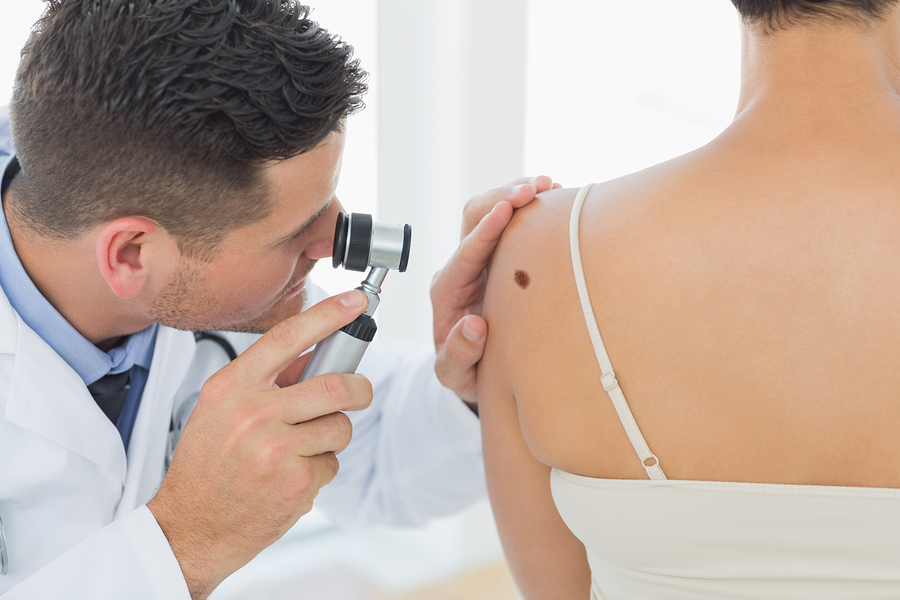Melanoma is a type of skin cancer that can occur anywhere on the skin. It may not be associated with sun exposure. Melanoma is a dangerous type of skin cancer that can grow and spread to other parts of the body and cause death. Melanoma can occur as a new mole or possible cause changes in an existing mole. Risk factors for developing melanoma skin cancer can be a family history in a first degree relative (mother, father, sister, brother), history of multiple moles or atypical moles. A history of sun exposure or tanning bed use can sometimes be associated. Performing monthly self-skin examinations can be helpful for early detection.

ABCDE's of Melanoma:
Prevention
Can be prevented by avoiding sun during peak hours 10am- 4pm, wearing sunscreen daily with repeat applications while outdoors, and/ or wearing protective clothing. Preventative skin exams are recommended to help diagnose and treat these areas.
Cure / Therapy
Melanoma treatment depends on stage. Early stages may be cured with surgery alone. More advanced stages of melanoma may require lymph node evaluation, or medical therapies.
Melanoma Staging
Staging of melanoma is based on the thickness or depth of the skin cancer, if there is ulceration or skin breakdown over the melanoma, and if the melanoma has spread to lymph nodes or other organs. Depending on the depth and severity of the melanoma additional testing may be required for staging. These tests may include:
- Lymph node mapping & sentinel lymph node biopsy
- CT Scan
- PET Scan
- Blood Testing
The staging system used is from the American Joint Committee on Cancer (AJCC): It is based on TNM classifications which stands for tumor, node (lymph node) involvement, and metastasis.
Stage 0
There are abnormal melanocytes in the epidermis, the outermost layer of skin.
Stage I
Cancer has formed, stage I is divided into two stages, IA & IB. No spread to lymph nodes or other organs.
- no more than 0.8 mm thick but has ulceration
- 0.8-1 mm with or without ulceration
Stage II
Divided into IIA, IIB, IIC: There is no evidence of melanoma in lymph nodes or other organs
- more than 1mm but not more than 2 mm thick, ulceration
- more than 2mm but not more than 4mm without ulceration
- more than 2mm but not more than 4 mm thick without ulceration
- more than 4mm without ulceration
- more than 4mm without ulceration
Stage III
Melanoma can involve any tumor depth with or without ulceration. Stage III involves spread to 1 or more lymph nodes.
Stage IV
The tumor has spread to other places, such as the liver, lungs, brain, bone, soft tissue or GI tract, spreading to places far away from where it started. Stage IV melanoma is categorized by any tumor depth with or without ulceration, and number of lymph nodes involved, and evidence of melanoma in at least 1 distant organ.
Treatment
The tumor has spread to other places, such as the liver, lungs, brain, bone, soft tissue or GI tract, spreading to places far away from where it started. Stage IV melanoma is categorized by any tumor depth with or without ulceration, and number of lymph nodes involved, and evidence of melanoma in at least 1 distant organ.
Melanoma is cut out with a margin of normal appearing skin. The amount of normal skin taken is dependent on the stage of the melanoma.
This procedure may take place over 3 days. The first day the melanoma is cut out with the margin of normal appearing skin. The wound is then bandaged and the patient may leave. The specimen is sent to the pathologist for evaluation. Once the results are returned, the wound can be closed and the patient is treated. If the results show melanoma cells are still present, the surgeon will remove the remaining cancer cells from the wound edge and have them rechecked by pathology.
Skin cancer is removed in the office, and the slides are prepared and evaluated while the patient waits.
Medications to halt or slow the growth of cancer cells.
Medication to stimulate your body’s immune cells to attack the cancer cells.
These new medications fight cancer by blocking genes that signal the cancer cells to growth. Your specific melanoma cells can be tested for these specific genes.
Schedule a Skin Cancer Screening
If you have concerns with the health of your skin or need further information on Skin Cancer types, treatment, or prevention, please feel welcome to call High Valley Dermatology.




